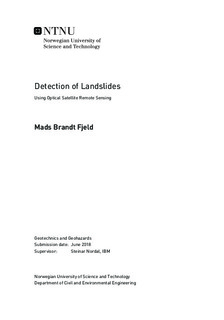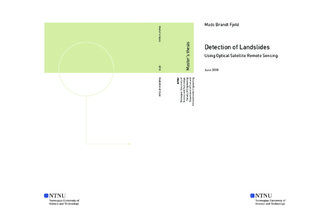| dc.description.abstract | Norway is exposed to frequent landslide activity. A large number of landslides occur in Norway each year, causing damage to infrastructure, or even loss of lives. Due to the changing climate and more extreme weather patterns, the landslide activity in Norway is expected to increase.
Different approaches and characteristics of satellite remote sensing data are evaluated for the purpose of detecting landslide activity in Norway.
The goal is to detect known landslide activity caused (partly) by an excess of water, using the optical satellite Sentinel-2.
A total of 25 landslides classified as either debris avalanches or debris flows have been identified from the Norwegian national landslide inventory. Sentinel-2 data have been acquired from the areas of the landslides, at times before and prior to the events, to investigate if the landslides are detectable in the satellite data.
11/25 of the investigated events are deemed detected in the acquired Sentinel-2 data, 3/25 are possibly detected and 11/25 are not detected. Landslide characteristics, spectral characteristics, and change detection methods are evaluated for all detected landslides.
The boundary of which an event can be deemed detected or not detected with high certainty is believed to be around 2000-2500 m2, corresponding to 20-25 pixels.
The spectral characteristics of the investigated landslides are found to have large variability. No unique signature is obtained from the examined
A change detection approach is found to have better accuracy with respect to automatic classification of landslide affected pixels based on spectral characteristics. S2-data acquired with similar lighting- and seasonal conditions are found to yield best results.
The S2-satellites are operational in Norwegian conditions but are limited by climatic conditions and large seasonal variations. Year-round coverage of satellite data to be used for landslide detection purposes is not available using Sentinel-2. S2-data acquired from the summer-season are found to have the best prerequisites for detecting debris avalanches and debris flow, due to the lighting- and vegetative conditions. | |

